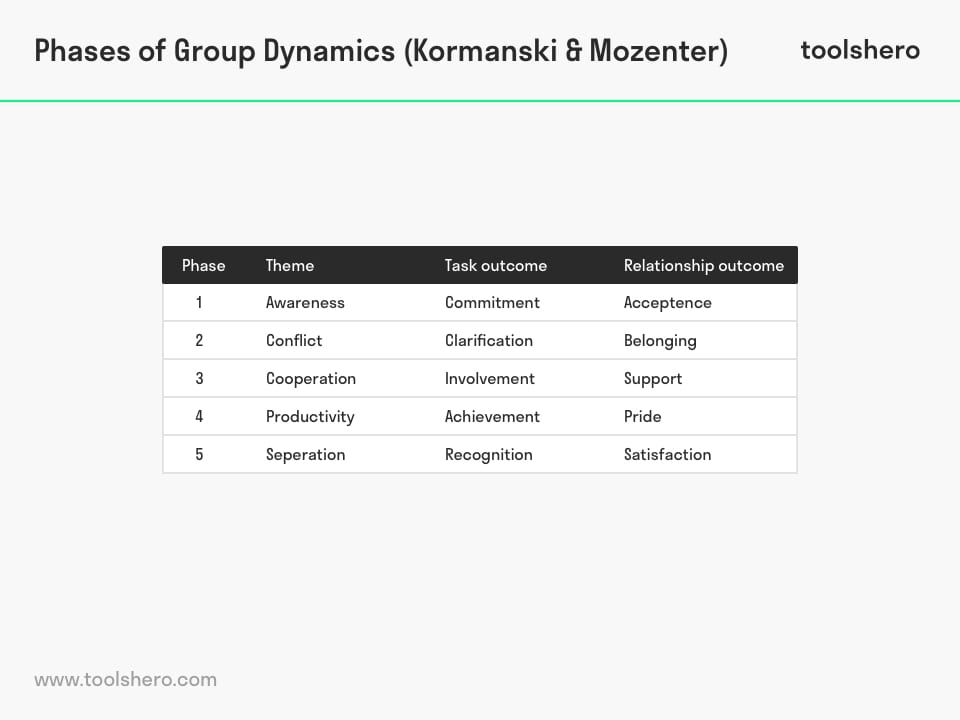Group Dynamics: the Definition and Theory

Group Dynamics: in this article, Group Dynamics is explained in a practical way. The article starts with a general definition of the term ‘Group Dynamics’, followed by a description of the various phases of development in groups. For each of the phases, the task outcome and and relationship outcome is stated. Enjoy reading!
What are Group Dynamics?
The social process by which people interact and behave in a group environment can be defined as Group Dynamics. Group Dynamics involves the influence of personality, power, and behaviour on the group.
The fact that a team is able to achieve more than an individual alone is no unknown. Traditionally, there are many benefits to cooperation.
No matter how brilliant, in many cases nobody can reach a specific goal alone.
Successfully working on a task or goal together in a team, however, does not happen automatically and one may be confronted with considerable barriers, like individual members behavior. These barriers do not necessarily have to form an obstacle for the team if they are adequately responded to.
The popularity and effectiveness of group development is evident from the number of studies that have been done into development in a team formation process.
Chuck Kormanski and Andrew Mozenter integrated the different theories, including the group processes model of Bruce Tuckman, in the model they published in 1987.
What are the five phases of Group Dynamics?
Just as in the personal development of a person, the process of team formation and development also has different phases.
Kormanski and Mozenter identified five phases in the process, each with a task outcome and a relationship outcome. The task outcome describes what effect the relevant phase has on the task of the team.

Figure 1 – the phases of Group Dynamics
The relationship outcome describes what effect the same phase has on the relationship between team members. They then gave each phase with different outcomes an overarching theme. The phases are sequential, which means that each phase is followed by the first subsequent phase.
1. Awareness
In this phase, the team members get to know each other and set the goals for the team. If everyone is aware of the intended results, this ensures that they are all aligned and that they are committed to each other and the goal.
This phase is important, no less than the next, because here one realizes that a common goal will be worked on. Everyone has different qualities and knowledge and therefore discovering everyone’s qualities and taking advantage of them is an important part of this phase of the model. Building trust between team members also begins in this first phase.
2. Conflict
Whereas in the first phase the team members became better acquainted with each other and the common goals, there is more interaction between each other in the second phase with regard to team activities.
Here the team starts to work together and there is a discussion about matters where opinions can differ. Group members perceive things differently, and this is shown in this phase.
In his Trust pyramid model, Lencioni already showed that constructive conflicts can be extremely valuable for the performance of the team. Constructive conflicts, if handled properly, ensure that unclear issues are clarified. Quarrels between team members also occur.
These should be approached with the utmost care because good rapport is essential. The fewer quarrels or personal attacks, the greater the psychological safety and the more the team members feel at ease.
3. Cooperation
Once the third phase is reached, efficient and effective collaboration takes place. Quarrels between team members have now been solved and team members know they can rely on each other. Good cooperation and group cohesiveness doesn’t necessarily mean that there are no more constructive conflicts.
The difference lies in the way in which these conflicts are approached. The respectful exchange of different visions ensures that group members feel involved and that a feeling of solidarity develops to a certain extent.
4. Productivity
The time and effort invested by team members in their common goal is visible in this phase by the increased productivity and the results that are achieved. If the results are positive, a feeling of pride will arise in the team. If the results are disappointing, it is important to work on a solution at this stage.
The decision may be made not to complete the project following long-term disappointing interim results or other (financial) reasons.
5. Closure
The feeling of pride that arises in the fourth phase of the process is now pronounced towards each other. Team members recognise that the results have only been made possible by the team as a whole.
In some teams, this phase also means the end of the collaboration, but if teams continue to work together, this phase is suitable for reflection.
By carefully analysing the course of events in the project and the results, one may notice elements that could be improved upon. In certain cases, SMART goals may be set for this.
Conclusion on Group Dynamics
The development of teams is a recurring process because the composition of a team can constantly change, but also the course on which the team works can be adjusted.
It is important that the dynamics between team members are recognised and clearly mapped out in order to be able to develop purposefully.
Supporting and tolerating each other ensures that acceptance and solidarity arise in a team. These factors increase the chance of positive results, after which the perceived feeling of pride and satisfaction is a fair reward for the achieved goals.
It’s Your Turn
What do you think? Do you recognize the explanation of group dynamics and how do you go about team development? Do you recognize the different stages in performing the above steps? What tips do you want to share about stimulating group dynamics and team building?
Share your experience and knowledge in the comments box below.
More information
- Tuckman, B. & Jensen, M. (1977). Stages of Small Group Development. Group and Organizational Studies, 2, 419-427.
- Kormanski, C. & Mozenter, A. (1987). A new model of team building: A technology for today and tomorrow. The 1987 Annual: Developing Human Resources and in Theories and Models in Applied Behavioral Science, Vol. 3, Management Leadership. San Diego, CA: Pfeiffer, 1991, p. 231.
- Kormanski, C. (1990). Team building patterns of academic groups. Journal for Specialists in Group Work, 15(4), 206-214.
How to cite this article:
Janse, B. (2018). Group Dynamics. Retrieved [insert date] from Toolshero: https://www.toolshero.com/leadership/group-dynamics/
Original publication date: 06/24/2018 | Last update: 01/16/2024
Add a link to this page on your website:
<a href=”https://www.toolshero.com/leadership/group-dynamics/”> Toolshero: Group Dynamics</a>












